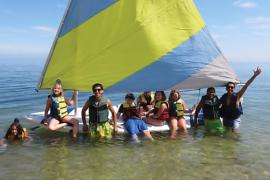Session length may not be as vital to the accomplishment of developmental outcomes as directors are anecdotally sharing. Interestingly, no empirical support exists for the conventional wisdom that longer sessions have better outcomes than shorter sessions for campers. Dimock and Hendry (1929) found that campers’ level of development in general did not significantly vary whether they were at camp one or two months. They cautioned that this finding might not appropriately represent the actual effect of camp due to limitations in the measurement tool. Comparably, ACA’s Directions (2005) reported that session length was not a reliable predictor of camper developmental outcomes. In other words, session length was not related to increased camper outcomes.
In 1929, Dimock and Hendry challenged the camp industry to measure character development resulting from the camp experience. Dimock and Hendry (1929) professed the importance of providing an educational experience within the camp context to develop youth socially as opposed to just offering activities. Although these words seem commonplace today (as they optimistically predicted), they also urged camps to measure the change in youth development. They believed that such an educational experience, empirically documented, would position the industry as a leader in character development. Dimock and Hendry (1929) also recognized “the difficulty and complexity of the task” of measuring changes in developmental outcomes (p. 262).
Though challenging, empirically documenting changes in developmental outcomes is possible. In fact, Dimock and Hendry (1929) stated, “any camp . . . is capable of gathering data, keeping records, and accumulating a fund of information which, especially when pooled with data on a wider scale, may be scientifically treated with valuable results” (p. 247). Perhaps this is a reason why the American Camp Association (ACA) has developed a Youth Outcomes Battery (YOB; Ellis & Sibthorp, 2006) containing eleven different scales that measure and document developmental change.
Utilizing three YOB scales, Roark (2008) empirically found a trend that the number of summers that campers attended camp increased their outcomes. The study investigated the relationship between three developmental outcomes of friendship skills, competence, and independence (FCI), and the number of summers campers attended. Results indicated that these outcomes incrementally increased as the number of summers that campers attended the same camp increased. Intuitively, it seems likely that the more time campers spend at camp during a summer session would then increase camper outcomes congruently with the length of session attended.
The ongoing discussion within the camp industry of, “Does the length of a camp session matter?” remains active. Some directors offering longer sessions believe that this type of camp experience has a stronger impact on behavioral change than camp sessions shorter in length. The primary outcomes recently cited in Camping Magazine for attending longer sessions (rather than shorter sessions) are developing relationships (i.e., friendship skills), skills (e.g., competence in activity and social skills), and independence.
The November/December 2011 Camping Magazine issue included various articles regarding the value of camps with differing session lengths. In one article, similar camper outcomes were shared regarding shorter camp sessions. Duntley (2011) anecdotally identified camper outcomes from parental feedback on their children attending shorter sessions. For example, parents noticed that their children were “more adept at relating to others [friendship skills]; demonstrating confidence, independence, and character values; making decisions about their own behavior choices;” and demonstrated their competence gained from “camp activities [and] skills they learned” (Duntley, 2011, pp. 28–29). Although Duntley (2011) identified outcomes from attending shorter sessions, he also believed that similar (not greater) outcomes could be gained in longer sessions. Duntley’s (2011), Dimock and Hendry’s (1929), and ACA’s (2005) evidence on session length contradicts the argument that longer sessions have a greater impact on camper developmental outcomes than shorter sessions.
Although the anecdotal evidence of session length is compelling, there is a need to verify it empirically. While Roark’s (2008) study provided evidence of the importance of returning to camp each summer, it did not address the relationship of session length to the developmental outcomes of FCI. Intervening factors such as the number of summers that campers attended camp and their age may affect (skew) the developmental outcome scores of FCI. Therefore, the purpose of this study was to examine the relationship between length of session and acquisition of FCI among youth campers while controlling for age and number of summers campers attended.
Methods
One self-report questionnaire that included the three scales of FCI was used. The scale measured participant change as follows: decreased (1), did not increase or decrease (2), increased a little (3), increased some (4), and increased a lot (5). Participants were aged 8–16 (n = 658) from one U.S. coeducational (54 percent female) private for-profit resident camp. The data were collected at the end of sessions. The session length variable was made up of two attributes consisting of a two-week (14 days with n = 246) and four-week (27 and 28 days with n = 412) category. Appropriate statistical tests were computed (i.e., reliability, adjusted means, standard deviations, strength of relationship, and analysis of covariance [ANCOVA] to test the nondirectional hypotheses of H0: μtwo week = μfour week). Covariates were camper age and number of summers campers attended.
Results
The scale reliabilities ranged from very good to good for friendship skills (a = .92), competence (a = .79), and independence (a = .81). Descriptive statistics are depicted in Figure 1. ANCOVA results indicated that a significant relationship exists between length of sessions and FCI outcomes (see Table 1). Results indicated that two-week session scores were significantly higher than four-week session scores. Effect sizes were small. Results also indicated that camper outcome scores increased for both two- and four-week sessions.
Implications
This study provides practical implications for camp directors and supports the anecdotal evidence suggested by Duntley (2011). Camper outcomes on FCI increased in both longer and shorter sessions. Specifically, slightly higher gains were found in shorter two-week sessions than the longer four-week session. Dimock and Hendry’s (1929) findings that camper development does not vary much when compared to session length were also supported.
As Dimock and Hendry suggested, analyzing and comparing developmental outcomes empirically can offer stronger support when making decisions about camp operations. Anecdotal evidence from parental feedback is a good guide, but to fully understand how, why, and where the positive difference occurs in camp, deeper inquiry was needed on length of sessions. For instance, it seemed intuitive that as the length of a session increased, the gains in camper outcomes would also incrementally increase. Yet, in this study, there was a statistical difference between the two- and four-week sessions on the FCI outcomes. Gains in two-week sessions were greater than four-week sessions. This is the opposite of what one might anecdotally believe about longer sessions providing greater benefits (e.g., friendship, competence, and independence) over shorter sessions. Despite this difference, it is very important to note that both the shorter and longer session lengths indicated an increase in the campers’ FCI outcomes.
This statistical difference between session lengths does not necessitate turning four-week programs into shorter two-week programs, but raises another question: what is actually causing the difference in the operations of each session? The difference in camper outcome scores provides camp directors with the opportunity to look deeper into what is influencing the developmental outcomes over different session lengths. Duntley (2011) suggested that with a shorter session, every component of the programming should be intentional in nature and have a direct impact. Perhaps increased intentionality produced a stronger sense of camper urgency with a shorter session to gain as much as possible in a two-week session than a longer four-week session that typically lets the outcomes such as friendship take place over more time.
This single empirical study does not fully answer all the inquiries surrounding the seminal question of “Does the length of a camp session matter?” This study, however, did empirically indicate that camper developmental outcomes of FCI increased regardless of session length for this camp. In other words, campers attending the shorter two-week and longer four-week sessions both increased outcomes measured in this study. This evidence suggests that the discussion of session length may not be as pressing as a variety of other ideas to ponder when making decisions about camp operations. Some factors that directors might further consider when managing session length decisions include:
- Saturation point in the progression of programming
- Personnel and camper burnout
- The difference in campers’ profile (e.g., scholarship v. full-pay campers) and bias (e.g., motivation to attend) in selecting a session
- The effect of a one-, three-, or seven-week sessions on camper FCI outcomes
- Comparison of other ACA developmental outcomes (e.g., teamwork, responsibility) or other camp features (e.g., camp affiliation, ethnicity)
With ACA’s YOB, collecting data on camper outcomes has become more streamlined. These resources, as demonstrated in this study, assisted a camp to collect, analyze, and empirically identify the differences of the camp experience based on session length. Dimock and Hendry would be proud to know we are evaluating camper developmental outcomes and telling the story beyond anecdotal evidence.
References
American Camp Association. (2005). Directions: Youth development outcomes of the camp experience. Martinsville, IN: American Camp Association.
American Camp Association. (2007). ACA Camper Enrollment and Staff Recruitment Surveys. Martinsville, IN: American Camp Association.
Dimock, H. S., & Hendry, C. E. (1929). Camping and character: A camp experiment in character education, New York: Association Press.
Duntley, (2011). It was the best week ever!: The value of one-week and short-term camp sessions. Camping Magazine, 84(6) 28-31.
Ellis, G., & Sibthorp, J. (2006). Development and validation of a battery of age appropriate measures for camper outcomes. Martinsville, IN: American Camp Association.
Roark, M. F. (2008). Relationships among select features of camps, the nature of interactions between and characteristics of camp personnel and campers, and campers’ acquisition of developmental outcomes relevant to the Self-Determination Theory. Unpublished Dissertation, University of Utah, Salt Lake City.
Mark F. Roark is an assistant professor of recreation at Utah State University. His twenty-two-year career includes directing resident, day, leadership, and wilderness camps. He now spends his passion for camp on evaluating camper developmental outcomes.
Originally published in the September/October 2012 Camping Magazine.



